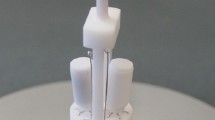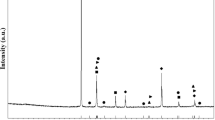Abstract
Iron-nickel alloys with certain compositions are known for their very exceptional properties: e.g., FeNi36 with a nickel content of 36 %, also known as Invar 36, shows a very low coefficient of thermal expansion (CTE). For this reason, the use of FeNi36 has revolutionized the design of many precision instruments. The special property of a very low CTE remains until the Curie point (\({T}_{\mathrm{Curie}}\)) is reached. In literature, Curie temperatures in a wide temperature range are reported for this material. Values between 230 and 280 °C can be found. Proper determination of the Curie point is essential to delimit the working temperature range of the material. In contrast to other materials, such as nickel, magnetic steel, electrolytic iron and cobalt, for which the Curie temperature can be deduced from DSC (Differential Scanning Calorimetry) and LFA (Laser/Light Flash Analysis) data, by identifying extrema in the Curie transition range, such an evaluation is not meaningful and realizable for FeNi36 data. In this study, the Curie temperature of FeNi36 was determined with STA (Simultaneous Thermal Analysis) following ASTM E 1582–21, yielding a value of \({T}_{\mathrm{Curie}}\approx 256^\circ \mathrm{C}\). It will be shown that the analysis of the inflection point of DSC, LFA, but also DIL (Dilatometry) data, can yield consistent values for the Curie temperature of FeNi36, too. However, the electrical conductivity measured by SBA (Simultaneous Determination of Seebeck Coefficient and Electrical Conductivity) did not show any evidence of the Curie point.








Similar content being viewed by others
Data Availability
Please contact the corresponding author. Original measurement data can be provided upon request.
References
G.T. Smith, Machine tool metrology – An industrial handbook (Springer International Publishing, Cham, 2016)
Y. S. Touloukian et al., Thermophysical Properties of Matter, VOL. 12, PT. 1 Thermal Expansion – Metallic Elements and Alloys, IFI/Plenum, New York – Washington, (1975)
R.J. Weiss, The origin of the ‘Invar’ effect. Proc. R. Soc. Lond. A 82, 281–288 (1963)
M.V. Schilfgaarde et al., Origin of the Invar effect in iron-nickel alloys. Nature 400, 46–49 (1999)
E.F. Wasserman, Chapter 3 Invar: Moment-volume instabilities in transition metals and alloys, in Ferromagnetic Materials, vol. 5, ed. by K.H.J. Buschow, E.P. Wohlfarth (North-Holland, Amsterdam, 1990), pp. 237–322
E.G. Moroni, T. Jarlborg, Calculation of Invar anomalies. Phys. Rev. B 41, 9600–9602 (1990)
Y. Wang, Thermodynamic fluctuations in magnetic states: Fe 3 Pt as a prototype. Philos. Mag. Lett. 90, 851–859 (2010)
Z.-K. Liu et al., Thermal expansion anomaly regulated by entropy. Sci. Rep. 4, 7043 (2014)
P. Gorria et al., Stress-induced Curie temperature increase in the Fe64Ni36invar alloy. Phys. Stat. Sol. (RRL) 3, 115–117 (2009)
J. Hasier et al., Curie temperature determination via thermogravimetric and continuous wavelet transformation analysis. EPJ Techn. Instrum. (2017). https://doi.org/10.1140/epjti/s40485-017-0040-y
ASTM Standard E1582, Standard Test Method for Temperature Calibration of Thermogravimetric Analyzers (ASTM International, West Conshohocken, PA, 2021). https://www.astm.org/. Accessed 28 Sep 2022. https://doi.org/10.1520/E1582-21
J. Blumm et al., A new method for the temperature calibration of laser flash systems, Thermal Conductivity 26, Thermal Expansion 14, Joint conferences, Cambridge, Massachusetts, USA, 6-8 August 2001
P. Grosseau et al., Curie temperature measurement by thermomagnetic analysis (TMA) and differential scanning calorimetry (DSC), XIV Convegno Nazionale di Calorimetria e di Analisi Termica, Dec 1992, Udine, Italy. Universita degli Studi di Udine, pp 281–285 1992
J. Terpiłowski et al., Investigation of phase transformation of Fe65Ni35 alloy by the modified pulse method. Materials 13, 342 (2020)
T. Peters et al., Thermal stress accommodation in dip cast lead zirconate-titanate ferroelectric films on flexible substrates. J. Am. Ceram. Soc. 105, 4058–4070 (2022)
Acknowledgements
The authors thank Dr. Jan Hanss and Dorothea Stobitzer for the DSC measurements, Doreen Rapp for the DIL measurements, Patrick Schütz for the sample preparation and Dr. Jürgen Blumm for fruitful discussions.
Funding
This work was done without any funding.
Author information
Authors and Affiliations
Contributions
AL and EP: planned and performed the experiments, evaluated the data, wrote the main manuscript text and prepared the figures together.
Corresponding author
Ethics declarations
Conflict of interest
The authors declare that they have no known competing financial interests or personal relationships that could have appeared to influence the work reported in this paper.
Additional information
Publisher's Note
Springer Nature remains neutral with regard to jurisdictional claims in published maps and institutional affiliations.
Supplementary Information
Below is the link to the electronic supplementary material.
Rights and permissions
Springer Nature or its licensor (e.g. a society or other partner) holds exclusive rights to this article under a publishing agreement with the author(s) or other rightsholder(s); author self-archiving of the accepted manuscript version of this article is solely governed by the terms of such publishing agreement and applicable law.
About this article
Cite this article
Lauerer, A., Post, E. Thermo-physical Properties of FeNi36 and Possibilities for Determination of the Curie Point. Int J Thermophys 44, 12 (2023). https://doi.org/10.1007/s10765-022-03124-8
Received:
Accepted:
Published:
DOI: https://doi.org/10.1007/s10765-022-03124-8




